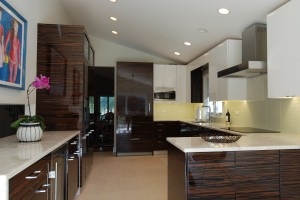Looking for a way to make your cabinets really pop? By adding a unique wood veneer, you can achieve grain, color, and texture unlike anything else you’ve ever seen before – at a fraction of the cost. Below, you’ll find our eight favorite veneers for custom cabinetry with everything you need to know…
Macassar is a generally light heartwood (in color), though it often has dark streaks running through it. Its unique grain sometimes produces a spider web effect, which looks sophisticated and elegant on any kitchen’s cabinets. Unfortunately, Madagascar can be quite difficult to come by with current trade restrictions. However, if you have the opportunity to buy any Macassar veneer already in the States, don’t pass up your chance!
Quarter Sawn Walnut
Quarter sawn wood is frequently seen in high-end musical instruments. It refers to a type of cut achieved by cutting a log lengthwise into quarters, and by then making parallel cuts. The effect is especially stunning when produced in walnut, a wood that is revered for its rich tones that sometime give way to unusual colors like maroon and purple. Be warned, walnut does cost about twice as much as most other woods.
Birdseye Maple
This wood is as mysterious as it is beautiful. An explanation for the tiny birdseyes that appear in the wood grain has yet to be sufficiently provided. Regardless, the effect that they can render on a well-cut piece of Maple is incredible.
Anigre
Though you’re familiar with walnut and maple, anigre is an entirely different wood. Grown in the tropical climate of east Africa, it’s one of the most affordable import woods available. If you want your custom cabinetry to have a light and “plain” look, anigre is the most sophisticated option you can go with.
Wenge
Though it’s another African wood, wenge is quite different from anigre. In addition to being more costly than anigre, it’s dark enough that it’s often substituted for ebony. Wenge’s large pores, coarse texture, and slight grain make it a wonderful choice if you want your custom cabinetry to be striking and robust.
Zebrawood
Priced similarly to wenge, zebrawood hails from the western side of Africa. Take a look at a section of zebrawood and you’ll have no difficulty understanding how it got its name. Zebrawood is light and cream-colored with dark brown streaks. Depending on the sawing technique, stripes can appear uniform or wavy. For a tropical wood, it’s remarkably strong. However, this factor shouldn’t make a huge difference in custom cabinetry veneer.
Rift Cut Oak
“Rift cut” is a term used to describe wood that’s cut perpendicular to the rings of a tree, resulting in the strongest possible type of grain. Its strength – enforced with the strength of oak – makes veneers like rift cut oak extremely unlikely to warp. Plus, the effect produced is beautiful. Tons of texture! Because this sawing technique wastes a lot of oak, prices can be high.
Sapele Wood
Similar to mahogany, this African import wood has reddish brown hues that make for a wonderful custom cabinetry veneer. Need three reasons why you should buy sapele wood? It’s dense like teak, harder than red oak, and reasonably priced.
Do you have a contemporary home? If so, veneers are the way to go. There are an unlimited amount of wood veneers available to you. Contact us if you would like help choosing the one that’s right for you.



